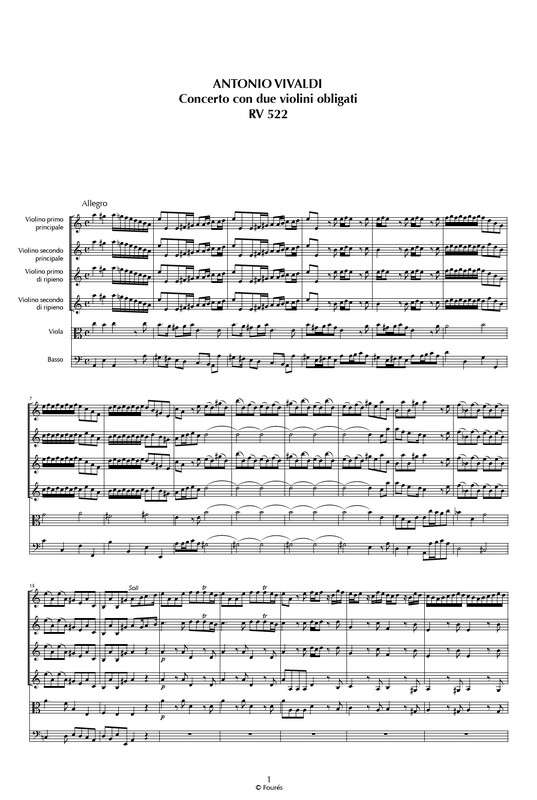AntonioLucio Vivaldi was one of the greatest Baroque composers that Italy had ever produced. He was a composer, a violinist, a priest and a teacher who was famous for composing the highly popular ‘The Four Seasons’ concertos played on the violin, a classic piece that is. Vivaldi, Antonio: Opus/Catalogue Number Op./Cat. RV 522; F.I.177; P.2; Op.3 No.8 I-Catalogue Number I-Cat. IAV 118 Key A minor Movements/Sections Mov'ts/Sec's: 3 movements: I. Allegro (A minor, 4/4) II. Larghetto e spiritoso (D minor, 3/4) III. Allegro (A minor, 3/4) Year/Date of Composition Y/D of Comp. 1711 or before First Pub.
“In 1711, Etienne Roger, the Amsterdam publisher, brought out what was to become the most influential music publication of the first half of the 18th century: Vivaldi’s L’estro armonico, Op. 3,” writes Michael Talbot, biographer of Antonio Vivaldi. Certainly, these 12 concertos for one, two, three, or four violins became widely known during their first years of publication. J.S. Bach knew them, and he transcribed six of them for organ or keyboard, one of which is this A-minor Concerto for two violins, strings, and basso continuo.
Vivaldi’s fast movements are famous for dash and verve, and the opening Allegro of this work is no exception. Add to that the catchiness of the themes, and you have the recipe that has fascinated listeners from J.S. Bach to our time. In the solo parts, Vivaldi gives us just the right balance between beauty and virtuosic display.



The Larghetto, too, is quintessentially Vivaldi. Like bookends, the full orchestra’s statements at the beginning and end enclose the soloists’ vocal-inspired melodiousness. The “bookends” consist merely of a brief bass line, which becomes a repeated cycle over which the soloists spin out free variations.

In the Presto finale, orchestra and soloists work together closely to give us a movement based on a multi-part ritornello theme. It all fits tightly together, with snippets of the theme launching brilliant passages from the soloists, until the close — which will leave many of us hungry for more.
“In 1711, Etienne Roger, the Amsterdam publisher, brought out what was to become the most influential music publication of the first half of the 18th century: Vivaldi’s L’estro armonico, Op. 3,” writes Michael Talbot, biographer of Antonio Vivaldi. Certainly, these 12 concertos for one, two, three, or four violins became widely known during their first years of publication. J.S. Bach knew them, and he transcribed six of them for organ or keyboard, one of which is this A-minor Concerto for two violins, strings, and basso continuo.
Vivaldi’s fast movements are famous for dash and verve, and the opening Allegro of this work is no exception. Add to that the catchiness of the themes, and you have the recipe that has fascinated listeners from J.S. Bach to our time. In the solo parts, Vivaldi gives us just the right balance between beauty and virtuosic display.
Vivaldi Rv 522
The Larghetto, too, is quintessentially Vivaldi. Like bookends, the full orchestra’s statements at the beginning and end enclose the soloists’ vocal-inspired melodiousness. The “bookends” consist merely of a brief bass line, which becomes a repeated cycle over which the soloists spin out free variations.
Vivaldi Rv 522 Midi
In the Presto finale, orchestra and soloists work together closely to give us a movement based on a multi-part ritornello theme. It all fits tightly together, with snippets of the theme launching brilliant passages from the soloists, until the close — which will leave many of us hungry for more.
